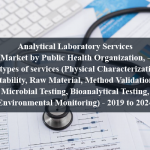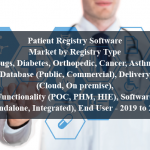OVERVIEW
The Real World Evidence Solutions Market is currently valued at USD 2 billion in 2024 and will be growing at a CAGR of 16.9% over the forecast period to reach an estimated USD 4.5 billion in revenue in 2029. The Real World Evidence (RWE) Solutions market serves as a pivotal bridge between clinical research and healthcare decision-making, offering invaluable insights into the safety, efficacy, and real-world outcomes of medical interventions. Leveraging data from diverse sources including electronic health records, claims databases, and patient registries, RWE solutions provide a comprehensive understanding of how therapies perform in routine clinical practice. This market encompasses a spectrum of services, including data collection, analytics, and interpretation, tailored to the specific needs of pharmaceutical companies, healthcare providers, and regulatory bodies. With the growing emphasis on evidence-based medicine and the increasing complexity of healthcare landscapes, RWE solutions play an indispensable role in shaping treatment strategies, informing regulatory decisions, and driving advancements in patient care. As the demand for evidence-driven insights continues to surge, the RWE Solutions market is poised for sustained growth and innovation, promising to revolutionize the way healthcare stakeholders harness data to improve outcomes and enhance patient well-being.
The escalating need for evidence-based decision-making in healthcare drives demand for RWE solutions, as stakeholders seek robust data insights to inform clinical practice, regulatory approvals, and health policy formulation. Additionally, the proliferation of electronic health records and digital health technologies generates vast reservoirs of real-world data, providing fertile ground for RWE solution providers to extract actionable insights. Moreover, regulatory bodies are increasingly recognizing the value of RWE in complementing traditional clinical trial data, spurring initiatives to integrate real-world evidence into drug development and post-market surveillance processes. Furthermore, the shift towards value-based care models, where reimbursement is tied to patient outcomes, incentivizes healthcare organizations to leverage RWE solutions to optimize treatment pathways, enhance patient outcomes, and contain costs. Lastly, the advent of advanced analytics techniques, including artificial intelligence and machine learning, empowers RWE solution providers to extract deeper insights from complex healthcare datasets, unlocking new possibilities for evidence generation and decision support.
Table of Content
Market Dynamics
Drivers:
The escalating need for evidence-based decision-making in healthcare drives demand for RWE solutions, as stakeholders seek robust data insights to inform clinical practice, regulatory approvals, and health policy formulation. Additionally, the proliferation of electronic health records and digital health technologies generates vast reservoirs of real-world data, providing fertile ground for RWE solution providers to extract actionable insights. Moreover, regulatory bodies are increasingly recognizing the value of RWE in complementing traditional clinical trial data, spurring initiatives to integrate real-world evidence into drug development and post-market surveillance processes. Furthermore, the shift towards value-based care models, where reimbursement is tied to patient outcomes, incentivizes healthcare organizations to leverage RWE solutions to optimize treatment pathways, enhance patient outcomes, and contain costs. Lastly, the advent of advanced analytics techniques, including artificial intelligence and machine learning, empowers RWE solution providers to extract deeper insights from complex healthcare datasets, unlocking new possibilities for evidence generation and decision support.
Key Offerings:
In the realm of Real World Evidence (RWE) Solutions, a diverse array of key offerings empowers stakeholders to harness the full potential of real-world data. These offerings encompass comprehensive data collection services, facilitating the aggregation and harmonization of disparate healthcare datasets from sources such as electronic health records, claims databases, and patient registries. Advanced analytics capabilities form another cornerstone, enabling stakeholders to derive actionable insights from complex data landscapes through sophisticated methodologies like predictive modeling, cohort analysis, and causal inference. Moreover, visualization and reporting tools play a pivotal role in translating raw data into actionable intelligence, empowering decision-makers to communicate findings effectively and drive evidence-based decision-making. Additionally, RWE solution providers offer consulting services to guide clients through the intricacies of real-world evidence generation, from study design and protocol development to regulatory submissions and strategic planning.
Restraints :
Even though Real World Evidence (RWE) Solutions have a lot of potential, their broad acceptance and efficacy are hampered by a number of important obstacles. The intricacy and variability of real-world healthcare data, which frequently lacks standardisation and quality control and can result in bias, incompleteness, and interoperability problems, is one of the biggest obstacles. Furthermore, worries about data security, privacy, and regulatory compliance create major obstacles to stakeholder collaboration and data sharing, which hinders the smooth flow of information necessary for RWE creation. Financial constraints that could discourage investment in RWE initiatives include the high expenses of data collecting, processing, and analysis as well as the restricted payment channels for RWE studies. Furthermore, the integration of RWE into standard clinical procedures is hampered by organisational and cultural constraints seen in healthcare facilities, such as reluctance to change and silos data management systems. Last but not least, the changing regulatory environment around RWE, which is marked by ambiguity and variety in norms and regulations, adds complexity and uncertainty, thereby discouraging stakeholders from completely adopting RWE solutions. To fully utilise RWE to promote evidence-based healthcare decision-making and enhance patient outcomes, these constraints must be removed.
Regional Information:
• In North America, the Real World Evidence (RWE) Solutions market thrives amidst a backdrop of robust healthcare infrastructure, technological innovation, and regulatory frameworks conducive to evidence-based medicine. The region boasts a rich ecosystem of data sources, including extensive electronic health records and claims databases, facilitating the generation of high-quality real-world evidence. Moreover, the presence of numerous pharmaceutical companies and healthcare organizations fosters collaboration and investment in RWE initiatives, driving market growth. Regulatory bodies such as the FDA in the United States have shown a growing openness to incorporating RWE into regulatory decision-making processes, further bolstering market dynamics. However, challenges persist, including concerns around data privacy and security, as well as the fragmented nature of healthcare delivery systems across states and provinces, which may hinder data interoperability and standardization efforts.
•In Asia-Pacific, the RWE Solutions market is poised for significant growth fueled by rapid economic development, expanding healthcare infrastructure, and increasing investments in digital health technologies. Countries such as Japan, South Korea, and Australia are at the forefront of RWE adoption, leveraging their advanced healthcare systems and robust data infrastructure to generate real-world evidence. Regulatory agencies in the region are gradually embracing RWE as a complementary source of evidence, albeit with varying degrees of readiness and regulatory clarity. However, challenges such as data fragmentation, cultural barriers, and disparities in healthcare access and quality pose hurdles to market development, requiring concerted efforts to address.
• In Europe, the RWE Solutions market reflects a diverse landscape shaped by varying healthcare systems, regulatory environments, and cultural nuances across countries. Countries like the United Kingdom, Germany, and France exhibit strong adoption of RWE solutions, driven by supportive regulatory frameworks and initiatives promoting evidence-based healthcare. The European Medicines Agency (EMA) has been proactive in exploring the integration of RWE into regulatory processes, fostering innovation and collaboration within the region. Nevertheless, disparities in data accessibility and quality, as well as differences in reimbursement policies and data protection regulations, pose challenges to market expansion and harmonization efforts across Europe.
Recent Developments:
• In August 2023, Parexel (US) announced a strategic collaboration with Partex NV (Germany) to leverage artificial intelligence powered solutions and accelerate drug discovery and development for biopharmaceutical customers worldwide. This collaboration aims to improve outcomes for patients and create an environment of continues innovation in leveraging advanced technology, data-driven insights and collaborative ecosystem.
• In June 2022, Franscisco Partners (US) acquired IBM Watson Health Business (US) and formed a new standalone company named Merative. This acquisition will help Merative in expanding reach of the healthcare data analytics products and improving healthcare delivery, decision making and performance.
Key Players:
IQVIA Holdings Inc., Optum, Inc. (a subsidiary of UnitedHealth Group), Cerner Corporation, IBM Watson Health, Oracle Corporation, SAS Institute Inc., Syneos Health, Anthem, Inc., Flatiron Health (a subsidiary of Roche), and PHARMO Institute.
1) What is the projected market value of the Real World Evidence Solutions Market?
– The Real World Evidence Solutions Market is expected to reach an estimated value of USD 4.5 billion in revenue by 2029.
2) What is the estimated CAGR of the Real World Evidence Solutions Market over the 2024 to 2029 forecast period?
– The CAGR is estimated to be 16.9 % for the Real World Evidence Solutions Market over the 2024 to 2029.
3) Who are the key players in the Real World Evidence Solutions Market?
– IQVIA Holdings Inc., Optum, Inc. (a subsidiary of UnitedHealth Group), Cerner Corporation, IBM Watson Health, Oracle Corporation, SAS Institute Inc., Syneos Health, Anthem, Inc., Flatiron Health (a subsidiary of Roche), and PHARMO Institute.
4) What are the drivers for the Real World Evidence Solutions Market?
– The growing demand for evidence-based healthcare decision-making is driving the demand for Real-World Evidence (RWE) solutions. The proliferation of electronic health records and digital technologies generates vast data, allowing RWE providers to extract actionable insights. Regulatory bodies recognize RWE’s value in drug development and post-market surveillance, and advanced analytics techniques like artificial intelligence enable deeper insights.
5) What are the restraints and challenges in the Real World Evidence Solutions Market?
– Real World Evidence (RWE) Solutions have potential but face challenges due to the complexity of healthcare data, privacy concerns, high costs, cultural barriers, and evolving regulatory landscape. These factors hinder the widespread adoption of RWE solutions, affecting data sharing, collaboration, and patient outcomes. Addressing these restraints is crucial for achieving RWE’s full potential in driving evidence-based healthcare decision-making and improving patient outcomes.
6) What are the key applications and offerings of the Real World Evidence Solutions Market?
Real World Evidence (RWE) Solutions offer comprehensive data collection services, advanced analytics capabilities, visualization and reporting tools, and consulting services to help stakeholders harness the full potential of real-world data. These services enable stakeholders to derive actionable insights from complex data landscapes, communicate findings effectively, and drive evidence-based decision-making.
7) Which region is expected to drive the market for the forecast period?
– North America is expected to have the highest market growth from 2024 to 2029
Why Choose Us?
Insights into Market Trends: Global Market Studies reports provide valuable insights into market trends, including market size, segmentation, growth drivers, and market dynamics. This information helps clients make strategic decisions, such as product development, market positioning, and marketing strategies.
Competitor Analysis: Our reports provide detailed information about competitors, including their market share, product offerings, pricing, and competitive strategies. This data can be used to inform competitive strategies and to identify opportunities for growth and expansion.
Industry Forecasts: Our reports provide industry forecasts, which will inform your business strategies, such as investment decisions, production planning, and workforce planning. These forecasts can help you to prepare for future trends and to take advantage of growth opportunities.
Access to Industry Experts: Our solutions include contributions from industry experts, including analysts, consultants, and subject matter experts. This access to expert insights can be valuable for you to understand the market.
Time and Cost Savings: Our team at Global Market Studies can save you time and reduce the cost of conducting market research by providing comprehensive and up-to-date information in a single report, avoiding the need for additional market research efforts.












